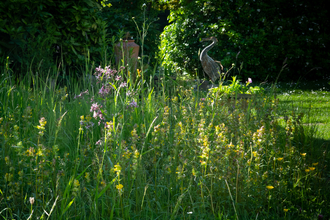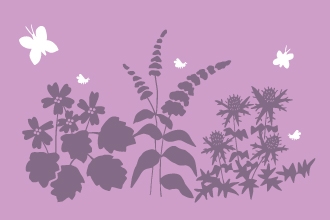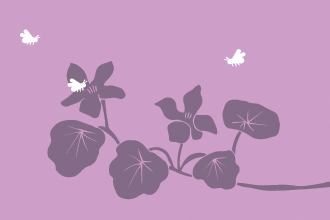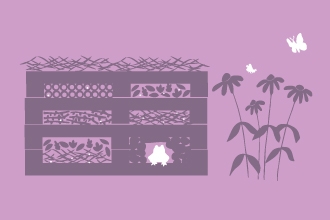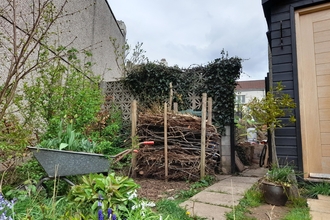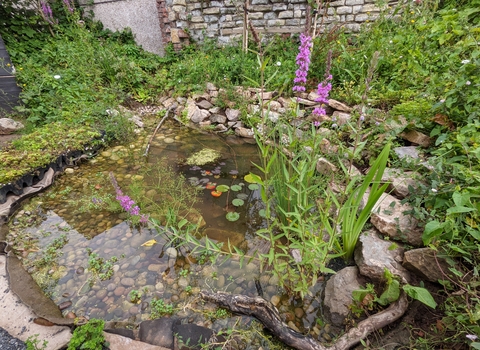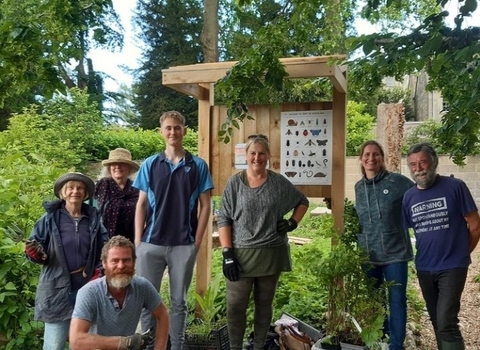
Stephanie Chadwick
Helen's wildlife garden in Yate
Individual garden: Helen Alloush
Name: Helen Alloush
Category: Individual garden in the wildlife gardening competition 2023 and 2024
Area: South Gloucestershire, Yate

Stephanie Chadwick
What makes your garden wildlife friendly?
Helen: In my garden a range of wildlife can find the shelter, food and water that they need to help them thrive. There is provision for those dropping in for a short visit, whilst others find what they require to establish a more long term presence here and stay or return year after year to raise new generations.
Projects undertaken especially to help nature include a log pile/dead hedge, a small pond, and conversion of part of the lawn to a mini wildflower meadow. I've made nest boxes for bluetits and great tits, a bird table, hedgehog hibernaculum, and currently under construction is a large insect hotel. All these were built entirely using leftover wood and scrap materials, at almost no cost at all!
My garden gives nature some space and the opportunity to do its own thing. It offers hedges, trees, flowers, some of these specially chosen to attract insects or birds, while native plants or "weeds" which have value to wildlife are allowed and encouraged to grow. Areas of uncut grass, water, abundant ivy and the absence of pesticides and herbicides all help to make my garden a welcoming place for wildlife.
Tell us what you love about your garden
One of the things I love most about the garden is the journey through each year as we experience the changing seasons, anticipating and enjoying the succession of plants and flowers and the cycle of wildlife that they support.
I love that each season has its own little wonders and wildlife events, whether it's a month buzzing with insects and birdsong and brimming with flowers, or a fruitful autumn with wildlife stocking up and finding shelter in preparation for colder months ahead.
I love watching spring unfold in the garden, from first shoots erupting and blossoms appearing, growth accelerating, and the wave of blue forget-me-nots that inevitably spreads over the garden every April, with bulbs popping up everywhere - tulips, alliums' while queen bumblebees are on the wing, mining bees busy, and so many other insects enjoying the feast of flowers! It's a joy to catch first sight of a hedgehog or slowworm emerging from hibernation. Meanwhile a general crescendo of birdsong fills the air as the breeding season is getting under way, and there's nothing I love more than being able to just step out of the house and be in the midst of our own little piece of nature.
Each flower or insect has its moment in the spotlight and sadly will fade away, but then there's still the palate of blazing summer colours to look forward to, bringing more butterflies, bees and other insects which are yet to emerge. I love the excitement on first spotting fledglings out of their nests, the parent birds busy non-stop feeding their young.
Whether simply relaxing for a few minutes, absorbing the surroundings and observing wildlife, or engaging in gardening tasks, the garden is also of great benefit to health and we always feel better and less stressed after spending a little time there. It's definitely my happy place.
I also love and feel excited when I see positive results from my efforts, such as Brimstone butterflies laying eggs on the hedge I had planted for them, then their caterpillars growing up there; bluetits nesting and raising young in the box I made for them; a hedgehog using the shelter I had built for it. I love the little surprise discoveries, like the painted lady caterpillar found growing up on a thistle, and the juvenile sparrowhawk that spent a few hours in the garden one day.

Stephanie Chadwick
What wildlife have you seen in your garden?
Wildlife seen in the garden includes a wide range of birds. The more common ones are seen every day, while others, such as flocks of long-tailed tits and goldfinches arrive less often, coming to feed on seeds etc. Very occasionally a sparrowhawk pays a visit, and greater spotted woodpecker and blackcaps are attracted to the nut feeders in winter.
Wood pigeons, magpies, blackbirds and robins all habitually nest in the trees. We were delighted to have a successful brood of blackbirds and robins this year, each with 3 offspring. Great-tits and bluetits also raised families here. It has been very enjoyable watching the fledglings grow up and become independent.
A colony of slowworms lives in the garden and individuals of different sizes are frequently seen around, or can sometimes on a warm day be found basking in large numbers under a corrugated sheet.
Frogs, are also seen and a huge range of flying and crawling invertebrates. At least 10 species of bees are regularly seen and currently leafcutters and common carders are quite prominent. I notice fluctuations in insect species and numbers from year to year. This year ladybirds of different sorts were abundant. Most plentiful of all were thick-legged flower beetles - possibly due to the overwhelming amount of oxeye daisies.
Butterflies are seen in the garden, though these too vary in number, some regulars breed here, such as the speckled wood, holly blue, which favours the high up ivy in the trees, and brimstone, which returns to the buckthorn in the hedge to lay eggs. Cinnabar moths deserve a mention, being more numerous than in any previous year, again due to their food plant, ragwort. The caterpillar covered plants are scattered throughout the garden.
Hedgehogs forage and are known to hibernate in the garden sometimes sleeping in their shelter. The latest new animal to add to the list is a fox. This night time visitor surprised us all when captured on a wildlife cam!
A very large variety of insects and other invertebrates are seen - too many to name here individually. Over the last few years, since taking actions to help nature, I have noticed new species appearing and increased numbers of others, especially solitary bees. Leaf-cutter bees are now a common sight, as are several species of mining and bumble bees. A new favourite, the hairy-footed flower bee, is now seen often, especially when brassicas are allowed to flower.
Hoverflies and bee mimics are also more various and numerous, as are beetles, and butterflies. Seven-spot ladybirds are among those observed to complete their lifecycle in the garden. Dragonflies and damsel flies are more frequently seen and bats hunting overhead are a regular sight at dusk.
My actions for nature have introduced or encouraged Meadow Brown, Ringlet, Gatekeeper, Holly Blue, Brimstone, Small Skipper and Speckled Wood butterflies; Scarlet Tiger, Cinnabar and Mullein moths; Speckled bush cricket and Field Grasshopper - to name but a few!
Helen was a finalist!
Stephanie Chadwick
When choosing new plants for your wildlife friendly garden, consider drought tolerant species when possible, which will require less water and be more resilient to climate change.
I would recommend keeping a notebook or diary to jot down wildlife observations, any actions for nature, gardening notes, when you mowed, etc. I find it makes a useful and interesting record which you can refer to and compare from year to year.

Stephanie Chadwick
Feeling inspired?
Helen has created a stunning and effective wildlife garden and gains huge enjoyment from gardening this way and appreciating the wildlife around her. Here are a few features and actions you could take for yourself, with advice from the Team Wilder Community Ecologist:
Mini Meadows and wild patches - It was great to see the longer grass where you mentioned that you only cut certain patches and leave the rest. This is good for over wintering invertebrates, amphibians and the slow worms! It is best to cut the remaining areas of the mini meadow once the plants have flowered – this can be early-late August. You might want to identify what wildflowers you have in the meadow and see when their flowering times are in order to determine when to cut (or just through observation!). In these areas that you cut once a year, you might want to plant some plug plants in so that the diversity increases.
Plug plants that would be good to see are common knapweed, self heal, yarrow and birds foot trefoil, as these are great for pollinators. You can find additional species on the suppliers websites below! I also recommend that you rotate the areas that you leave over winter each year (e.g. cut different parts of the meadow each August).
Plantlife: meadows
Plantlife: meadow management
Magnificent Meadows
Grow Wilder offers native, ethically sourced seeds and wildflowers with a local origin of Bristol. Many of the wildflower seeds have been collected from Avon Wildlife trust reserves.
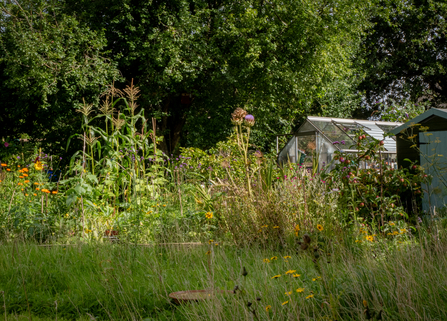
Stephanie Chadwick
Great that you have planted early and late flowering plants within the garden to extend the growing season. this resource lists particular species:
The best plants for bees and pollinators
Advice for habitat creation: There are many effective ways to create habitat space for wildlife in gardens of all shapes and sizes - at home and in teh community.
Team Wilder wildlife ponds
Team Wilder wildflower meadow creation
Team wilder dead hedges
Resources
For more amazing inspiration see Helen's instagram: @helens_lens_
Be part of Team Wilder
Feeling inspired by this wildlife garden? Try something for yourself at home, in your community, school, business or land, no matter the size.
All actions for nature collectively add up and makes a difference for people and wildlife.
Share your actions for nature, like Helen, and motivate others to do the same.
Log your actions for nature on the map












